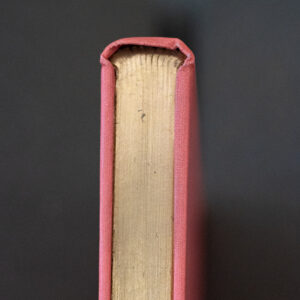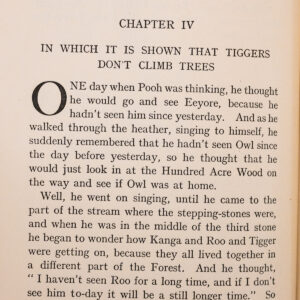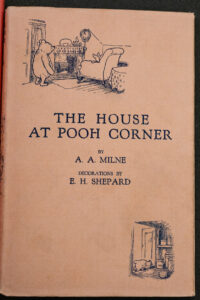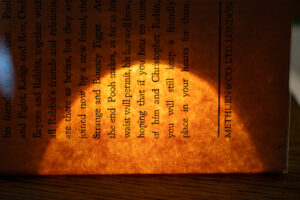By John F Ward
This copy of The House at Pooh Corner is rare. Published in London in 1928, it’s a first trade edition released in the author’s native land — among the first copies printed for sale to the general public. Plus, it’s signed by A.A. Milne, also author of three previous Winnie-the-Pooh books, all rather successful. That signature, though, may not be quite as rare as the book.

There were more than 800 copies printed in addition to the first trade edition around the publication date. Most of those early special editions were numbered in the series, and many were signed by Milne (as this volume is) and his illustrator, Ernest H. Shepard (whose signature is not found in this book).
All that notwithstanding, this copy from this first trade edition is indeed rare. One online estimate suggests the first British print run was just 350 copies, and this volume is one of those. [www.baumanrarebooks.com/blog/the-story-behind-a-a-milnes-pooh-books]
This particular edition was published in England by Methuen & Co. Ltd., a London publisher from 1892. It was printed by Jarrold and Sons Ltd. of Norwich, some 200 km northeast of London — the printing and binding division of a much larger diversified company. I suspect Jarrold also bound the books. Publication in the U.S. was handled by E.P. Dutton & Co.
This codex measures 19.3 cm x 13.3 cm x 2 cm. It is covered with rose cloth and is protected by an extensively printed dust jacket of pale peach. The binding remains very tight 95 years into the book’s life, with 11 signatures glued to backing paper and into the spine.

There are small Arabic numbers at the bottom left corner of every 16th page (recto), suggesting the book was laid out on octavos.

The text is printed in black ink on white wove paper that has mostly been neatly trimmed, although several leaves (such as Page 111) were not prominent enough to be cut clean, so their outside edges are rougher.
It is possible that this book could have been printed on offset presses, using round drums and flexible plates made of tin that are made from large negatives and then processed. That process was developed in the late 19th century and refined for paper around 1908. It is also possible that the book was printed using metal type — individual letters set by hand and gathered into chases — a flat process in which each signature was printed (one face at a time) and later folded and cut into the folia we see in the finished book. These technologies overlapped in the early 20th century, and I could find no production notes for this particular volume or for Methuen (the British publisher) or Jarrold (the British printer).
The 10 chapter headings carry “CHAPTER [Y]” at the top right of each opening page, with the “[Y]” representing a Roman numeral, I-X. The text of each new chapter begins with a 1.1cm x 1.1cm, 3-line drop cap (approximately 30 points) that transitions into a conservative serif typeface with an approximate type size of 6 to 8 points. (It could be Baskerville, developed in the 1750s by John Baskerville and a fairly common book font, especially in the early 20th century.)

Based on the condition of the book and jacket, I believe the owner, George W. Davison (Wesleyan Class of 1892 and a major benefactor to the school), bought or received this book soon after it was published, and kept it carefully. From a Wesleyan article credited to Suzy Taraba ’77, University Archivist: “Davison worked closely with book dealer Philip Brooks, who acted as his agent,” perhaps explaining why Davison, an American, owned the British edition. His ownership is evidenced by a book plate affixed to the front pastedown.
Davison ultimately gave Wesleyan at least some volumes from his collection of books, now called The Davison Collection. This volume, perhaps in very good condition, possesses something that may be even more rare for a book celebrating its 95th birthday: a dust jacket in good condition. There is very little chipping on the spine, and a small amount of compression at the top of the spine of the dust jacket.

The dust jacket is a very pale peach color. I shined a flashlight through it and discovered no discernible grain pattern, suggesting the paper is wove. But the dust jacket paper has a distinct physical pattern, visible when a light is shined askew at the surface — more like a laid pattern. The pattern is just deep enough to be felt by sensitive fingers.

Another first trade edition published by Methuen in London in 1928 (for sale on biblio.com from an Australian antiquarian book dealer for about USD11,000) has a dust jacket of a faded pale blue. I found photographs of two other dust jackets from early copies of the British release and none of them matched the Davison jacket or the pale blue, suggesting there were different dust jackets produced for different editions of the book.
Physical description: [vi] , 178 pages : ill. ; 20 cm (8vo)
Signature statement: i0 1-118
Material description: Black ink printed on wove paper, 19.3cm x 13.3cm x 2cm. Eleven signatures are simply glued into the binding, with no evidence of any sewing. The covers and all the leaves in this codex look original and are without significant damage. There are no visible repairs. The covers are hard boards of 0.3-0.4cm thick and look to be in near-fine condition, as is the cloth they are wrapped in. There is a book plate affixed to the verso of the front cover. Signed by the author on the title page.
